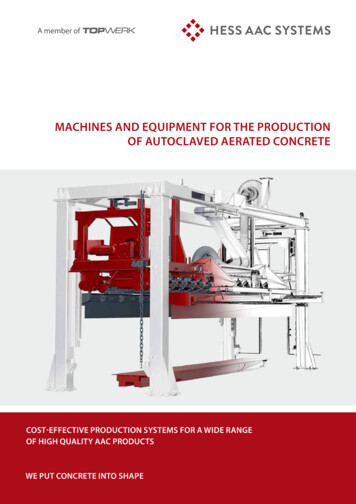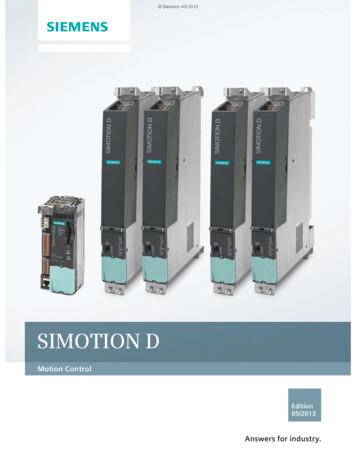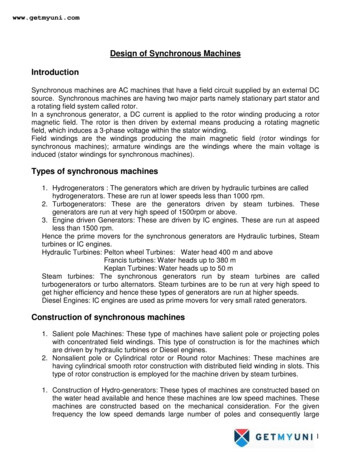
Transcription
Machines and equipment for the productionof Autoclaved Aerated ConcreteildbletTi?Cost-effective production systems for a wide rangeof high quality AAC productsWe put concrete into shape
AAC TechnologyThe Autoclaved Aerated Concrete (AAC) material wasdeveloped in 1924 in Sweden. It has become one of themost used building materials in Europe and is rapidlygrowing in many other countries around the world.Autoclaved Aerated Concrete is a lightweight, loadbearing, high-insulating, durable building product,which is produced in a wide range of sizes and strengths.AAC offers incredible opportunities to increase buildingquality and at the same time reduces costs at the construction site.AAC is produced out of a mix of quartz sand and/or pulverized fly ash (PFA), lime, cement, gypsum/anhydrite,water and aluminium and is hardened by steam-curingin autoclaves. As a result of its excellent properties, AACis used in many building constructions, for example inresidential homes, commercial and industrial buildings,schools, hospitals, hotels and several other applications.The construction material aircrete contains 60% to 85%air by volume. The solid material is a crystalline binder,which is known as Tobermorite. The chemical composition of Tobermorite shows silicium dioxide, calcium oxide and water. Besides the binding phase Tobermorite,AAC contains grains of quartz and in minor amountssome other minerals.2The silicium dioxide is obtained from silica sand, fly ash(PFA), or crushed quartzite. It is possible to obtain silicium dioxide as a by-product from other processes, e.g.foundry sand. The calcium oxide is obtained from quicklime, hydrated lime and cement. Gypsum/anhydrite isadded in small quantities as a catalyst and for optimizing the properties of AAC. Aluminium powder/paste isused as expanding agent.In specific applications additional (chemical) components can be added to enhance the AAC properties during production and in the final product. Special agentsallow the use of certain waste materials as a valuablenew raw material for the production of high quality AAC,hence adding to sustainability and a circular process.Advantages of AAC Large variety of sizes: AAC can be produced in alarge variety of sizes, from standard blocks to largereinforced panels; Excellent thermal insulation: AAC has a very lowthermal conductivity and therefore a very highthermal energy efficiency is achieved.This results incost savings for heating and cooling; Termite resistance: AAC can not be damaged bytermites or insects; High workability: as a result of the excellent size/weight ratio, AAC allows rapid construction work.Even though AAC is a solid building material, it canbe cut, sawn, drilled, nailed and milled like wood,making it an easily workable product; Extremely lightweight: AAC weighs approximately50% less than other comparable building products; High compressive strength: AAC is a solid product,therefore making it highly load bearing. The entiresurface area is used in structural calculations; High dimensional accuracy: as a result of itsdimensional accuracy, AAC is extremely easy toinstall, as no thick set mortar is required; Great acoustic insulation: the porous structure ofAAC provides a high acoustic insulation; High fire resistance: AAC has an extremely high fireresistance rating of at least 4 hours;3
HESS AAC SystemsCompact Line - CBT1.ball mill system for milling sand and course anhydrite2.slurry tanks3.silos for lime, cement and fine anhydrite4.aluminium powder / paste preparation5.dosing and mixing6.casting into the mould7.position for reinforcement insertion8.rising / pre-curing9.position for extraction of reinforcement holding pins10. tilting the cake with tilting manipulator11. mould oiling12. pre-cutting13. vertical cutting and profiling14. horizontal cutting15. cross cutting and handgrip milling16. platform manipulator17. back-tilting of the cake onto a cooking frame18. platform return and bed waste removal19. green separation20. multifunctional manipulator21. stacking and buffering of green cake22. autoclaving23. steam preparationKeen-Crete - KBT24. buffering and destacking of hardened cakes25. frame circulation, cleaning and oiling26. unloading and transfer to the packaging line27. pallet destacking and transportation28. covering with foil45
AAC production processReinforcement preparationThe HESS systems are also ideal for the production of large format reinforced panels. Depending on the requiredcapacity, the reinforcement cages are outsourced or welded on site. The cages are then assembled per mould andhung onto holding frames with cross bars and needles. A corrosion protection is then applied. Immediately after themix has been poured into the mould, the waiting reinforcement frame assembly is inserted. Before cutting of thecake, the holding frames with needles are lifted, leaving the reinforcement in the cake.Raw material preparation and mixingA ball mill wet-grinds the quartz sand with water to asand slurry. The sand slurry is stored in slurry tanks andpumped into the slurry weighing hopper in the mixertower. The binders (lime, cement and anhydrite) arestored in silos. It is also possible to mill the anhydrite together with the sand in the ball mill. The aluminium powder or paste is prepared in a separate building where it isdispersed in water.Casting, rising/pre-curing andmould circulationThe mould consists of four fixed sides and one detachable platform. The inner mould surfaces are covered withdemoulding release oil before casting. This oil is appliedeither manually or automatically. The mix is then pouredinto the moulds. A mould circulation system conveys themoulds to the rising area, where the cake pre-cures for2-3 hours after which it is ready for cutting. Dependingon the plant design, the moulds are handled by a mouldtraverser or by a tilting-manipulator.6All the components are accurately weighed, and are released into the mixer in a pre-defined order. The HESSrecipe and temperature control system constantly monitors this process.HESS also has the knowledge and the experience to produce AAC with alternative raw materials, for examplewith fly ash.TiltingThe tilting manipulator tilts the mould by90 . The manipulator unlocks the mouldand removes the mould body, so that thecake remains on one mould side/platformfor cutting. This tilting system has provento be the safest method for tilting the cakeinto the vertical cutting position, as the cakeis remaining on the platform/mould side forthe cutting process.This way of handling results in optimal efficiency in raw material consumption due tothe low mechanical forces on the productin the green stage and reduces the risk ofcracks and product damage.7
AAC production processCuttingThe cake is cut by high precision cutting machines.Cutting is done by cutting knives and by pneumatically tensioned cutting wires. The pre-cutter and vertical cutter cut the blocklength and panel width. In this station theprofiling (tongue and groove) can be cut into thecake with profiling knives; The horizontal cutter cuts the block and panelthickness; for special demands in surface finishand thickness accuracy beyond the traditionalbuilding standards, HESS provides provenalternative cutting systems with oscillating wireswhile maintaining the advantages of the tilt cakecutting system; The cross cutter cuts the block height and thepanel length. Optionally hand-grips can bemilled in the blocks in the green stage;89
AAC production processBack-tilting and bed removalThe HESS plants have combined the advantages of thetilt-cake and flat-cake system. After the cutting is completed, the cake is tilted back by 90 onto a cookingframe. In the HESS system no part of the mould or platform used for cutting goes into the autoclaves. After thecake has been tilted back into the horizontal orientation,the bottom/bed waste will be removed before autoclaving. Autoclaving the cake horizontally on the cookingframes allows efficient autoclave loading and, most importantly, will prevent most of the sticking of the layers,which is a typical disadvantage of the traditional tiltcake systems.HESS SYSTEMS PRODUCE NO PROCESS RELATEDWASTE!Frame and bogey circulationThe green cakes on the cooking frame are stacked threehigh onto autoclaving cars, referred to as bogeys. Autoclave buffer tracks in front of the autoclaves ensure thatthe cutting and packaging processes are less dependent on one another. An autoclave traverser is used forloading and unloading the autoclaves, ensuring that thisprocess is performed in the shortest possible time, in order to optimise autoclaving capacity.AutoclavingOne of the HESS innovations is the green separator. Herethe horizontal cuts (now laying vertical) are carefullyseparated before autoclaving, leaving a small gap between the layers. This innovation eliminates any sticking,which is typical for other tilt-cake systems. Further thisgreen separation substantially improves the autoclavingprocess as steam can penetrate into the cake more effectively. Although the principle of separation has oftenbeen copied, the HESS technology for this productionmethod has been proven as the most reliable with thelowest risk of product damage.10In the autoclaves the cakes are cured for ca. 10–12 hoursat a temperature of 190 C with saturated steam at apressure of 12 bar. The fully automatic autoclave controlsystem ensures a safe and optimal autoclaving process,also allowing for steam transfer and energy reuse incombination with the condensate system, in order to cutback fuel costs for the steam generation to 50%.11
AAC production processProcess control and plant automationThe entire production process is controlled by modernautomation systems designed by HESS on the basis of Siemens S7 control system, using standard components thatare available world-wide. User-friendly, multi-lingual operator interfaces with touchscreen monitors allow easy andunderstandable operation. The HESS remote diagnosticsdo not only allow access for on-line support but are supported with modern Industry 4.0 technology. Cloud baseddata collection technologies allow the user to be in controlover the production process on-line with a wide range ofdiagnostics available at hand wherever desired.Unloading and packingAfter the autoclaving is completed, the cakes aredestacked and unloaded from the cooking frames. HESSoffers a large variety of packaging solutions, ensuringthat the finished products are packed according to localmarket requirements. Usually blocks will be delivered aspacks on wooden pallets, strapped and/or covered infoil.HESS also offers a wide range of post-autoclaving handling for reinforced products, such as packaging lines,sawing and shaping systems.Process know-howHESS has a modern laboratory, equipped with all necessary equipment and apparatus to perform vital raw material tests. Not only the raw material characteristics arechecked, but also small scale AAC production is possible,allowing HESS to gain important information on raw material production behaviour and final product quality,to ensure trouble free putting into commercial operation of the plant after a green field installation or majormodification.1213
Upgrading existing systemsCompact Line – CBTCBT-210CBT-320CBT-430Theoretical capacity210 m³ / day320 m³/day430 m³/dayCakes / day75120160Cycle time18,0 min / cake11,3 min/cake8,4 min/cakeNo. of autoclaves (32 m)234No. of rising places91317Net cake size3,0 x 1,5 x 0,6 m 2,7 m³Compact Line CBT – HPCBT-HP 300CBT-HP 450CBT-HP 600CBT-HP 750Theoretical capacity300 m³/day450 m³/day600 m³/day750 m³/dayCakes / day5684112140Cycle time24,4 min/cake16,1 min/cake12,1 min/cake9,6 min/cakeNo. of autoclaves (37,5 m)2345No. of rising places7111417Net cake sizeKeen-Crete Line – KBT-SKBT-S-450KBT-S-680KBT-S-900450 m³ / day680 m³ / day900 m³ / dayCakes / day84126168Cycle time16,1 min / cake10,7 min / cake8,0 min / cakeNo. of autoclaves (43,7 m)234No. of rising places91318Theoretical capacityUpgrade of existing Hebel type cutting systemsIn order to increase the quality of the product as well asthe reliability of the plant, without investing in a complete new cutting machine, the modification of the Hebel technology based cutting machine is possible.Highlights Short installation time; Proven technology; The existing logistics and production technologydo not require major changes; Cutting table with moving bridges; Needles with rectangular design; Balance opposed double set of cross cutting shafts; Vertical wire tensioning system; Top crust removal system; Horizontal cutting system for lintel cutting; Counter pusher with pusher package; Bottom and top profiling system; Control system; Hydraulic system;HESS can also undertake the modification of other AACplant systems.6,0 x 1,5 x 0,6 m 5,4 m³Net cake sizeKeen-Crete Line – KBTTheoretical capacity6,0 x 1,5 x 0,6 m 5,4 m³KBT-900KBT-1130KBT-1360KBT-1580900 m³/ day1.130 m³/ day1.360 m³/ day1.580 m³/ dayCakes / day168210252294Cycle time8,0 min / cake6,4 min / cake5,4 min / cake4,6 min / cakeNo. of autoclaves (43,7 m)4567No. of rising places18232732Net cake sizeBased on HESS vast experience with many differentproduction systems and technologies, HESS can carryout a AAC plant assessment. During this scan differentaspects of the operation are thoroughly reviewed likethe process technology and quality control, the production plant and its condition as well as the organisationand management of the factory to find the right anglesfor improvement of the business and making it moreprofitable.Keen-Crete Line – KBT-L6,0 x 1,5 x 0,6 m 5,4 m³KBT-L-1580KBT-L-1810KBT-L-20401.580 m³/ day1.810 m³/ day2.040 m³/ dayCakes / day294336378Cycle time4,6 min/ cake4,0 min/ cake3,6 min/ cakeNo. of autoclaves (43,7 m)789No. of rising places333841Theoretical capacityNet cake size6,0 x 1,5 x 0,6 m 5,4 m³Based on a pre-curing time of 2,5 h and on 2 autoclave cycles/day. These are dependent on raw materials and product mix. Other autoclavelengths and net cake volumes are possible and will change the capacity data. Reinforced products with a length of max. 6 meters can be produced on all Keen-Crete Lines1415
HESS AAC SYSTEMS B.V.Aluminiumsteden 107547 TN EnschedeP.O. Box 100637504 PB Enschede, The NetherlandsPhone:Fax:E-Mail:Internet: 31 53460 1700 31 53460 1799info@hess-aac.comwww.hess-aac.comnew dimensions in cocrete shaping
The construction material aircrete contains 60% to 85% air by volume. The solid material is a crystalline binder, which is known as Tobermorite. The chemical composi-tion of Tobermorite shows silicium dioxide, calcium ox-ide and water. Besides the binding phase Tobermorite, AAC contains grains of quartz and in minor amounts some other minerals.











